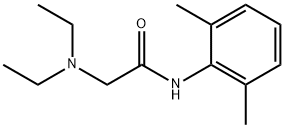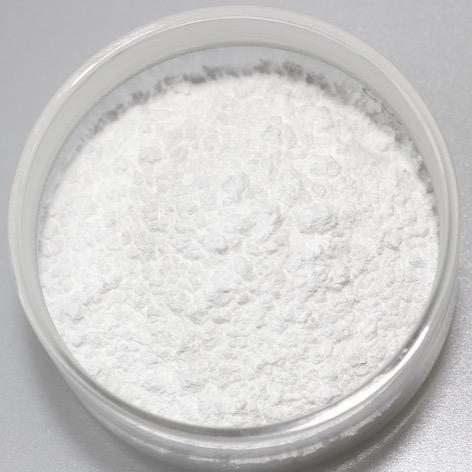What is Lidocaine used for?
Lidocaine was the first amide local anesthetic suitable for nerve blocks in dentistry and because of its reliability is currently the most commonly used local anesthetic solution in dentistry in the United States. It has become the standard with which other local anesthetics are compared.
Pharmacologically, lidocaine is a xylidine derivative. It is approximately two times more potent than the ester procaine, and when injected intraorally, produces greater depth of anesthesia.6 Because lidocaine is a potent vasodilator, it only offers pulpal anesthesia of 5 to 10 minutes, and therefore is rarely used in dentistry without a vasoconstrictor. However, when the commonly used formulation of 1:100,000 epinephrine is used, it provides profound pulpal anesthesia of approximately 60 minutes and soft tissue anesthesia of up to 5 hours with low risk of systemic toxicity and no documented allergic reactions.6 The 1:50,000 formulation provides no further pain control than the 1:100,000 formulation and increases the risk of adverse cardiovascular reactions. Elderly patients are more likely to be hyperresponders to vasoconstrictors, and in these individuals the 1:100,000 formulation should be used.4 However, the 1:50:000 formulation does provide greater vasoconstriction offering better hemostasis than the 1:100,000 formulation, and therefore should be reserved for procedures that require bleeding control.
Lidocaine is equal in potency to mepivacaine and prilocaine. It is two-thirds as potent as articaine and one-fourth as potent as bupivacaine. Lidocaine is similar in toxicity to articaine. It is slightly more toxic than mepivacaine (approximately 25% more) and prilocaine (approximately 40% more). It is far less toxic than bupivacaine, only one-fourth as toxic .
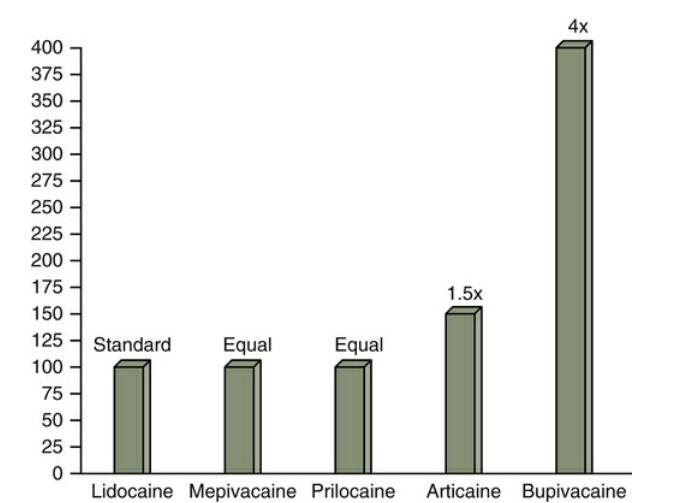
FIGURE 1 Relative potency values for amide local anesthetics compared with lidocaine. Using lidocaine as the benchmark with the reference value of 100% for the comparison, this figure demonstrates that mepivacaine and prilocaine are equal to lidocaine in potency. Articaine is 1.5 times more potent than lidocaine, and bupivacaine is 4 times more potent.
Lidocaine has anticonvulsant properties and may be used to terminate or decrease the duration of grand mal and petit mal seizures. These anticonvulsant properties occur at blood levels below that which lidocaine produces seizure activity in an overdose. Lidocaine decreases the excitability of neurons due to its depressant actions on the central nervous system (CNS), thus raising seizure thresholds.4 In addition, patients may experience initial sedative effects from lidocaine compared with other local anesthetic agents. During toxic overdose reactions from local anesthetics, initial CNS stimulation is followed by CNS depression (see Figure 5-5). With lidocaine, the stimulation phase may be nonexistent or brief, displaying signs and symptoms of initial CNS depression rather than CNS stimulation.
Lidocaine is also an effective topical anesthetic and is currently the only topical amide anesthetic on the market. Lidocaine is metabolized in the liver through a complex pattern that uses several hepatic enzymes, and less than 10% of lidocaine is excreted unchanged by the kidneys. Individuals with significant hepatic disease can receive lidocaine but at a reduced dose.
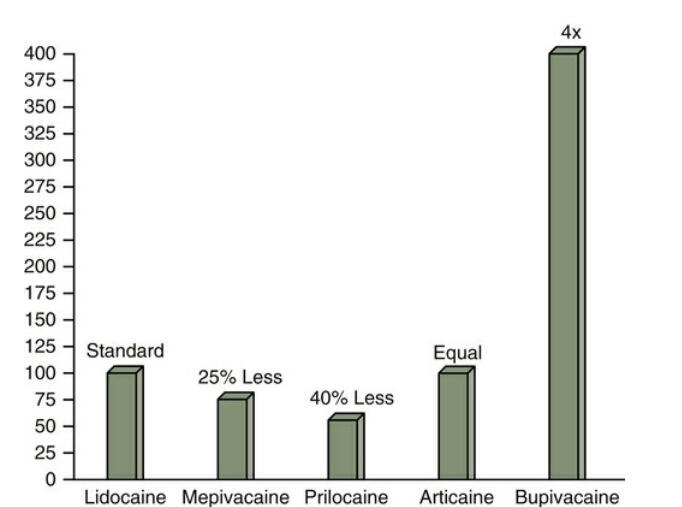
FIGURE 2 Relative toxicity values for amide local anesthetics compared with lidocaine. Using lidocaine as the benchmark with the reference value of 100% for the comparison, this figure demonstrates that articaine is equal in toxicity to lidocaine, mepivacaine is 25% less toxic than lidocaine, and prilocaine is 40% less toxic than lidocaine. Bupivacaine is the most toxic and is 4 times more toxic than lidocaine.
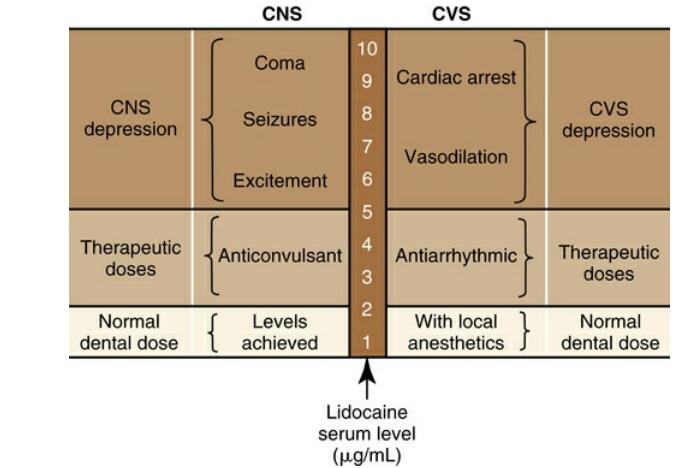
FIGURE 3 Relationship among levels of local anesthesia in serum and the pharmacologic and adverse effects. CNS, Central nervous system; CVS, cardiovascular system. (From Haveles B: Applied pharmacology for the dental hygienist, ed 7, St Louis, 2016, Mosby.)
Lidocaine is available in three different formulations: 2% plain, 2% 1:50,000 epinephrine, and 2% 1:100,000 epinephrine. Table 5-6 lists the main properties of lidocaine, and Tables 5-7 through 5-9 give helpful tips for anesthetic selection and precautions for lidocaine formulations for specific guidelines related to the precautions for local anesthetics and vasoconstrictors).
The maximum recommended dose (MRD) for lidocaine is 3.2 mg/lb or 7.0 mg/kg, and the absolute MRD is 500 mg.
);You may like
Related articles And Qustion
See also
Lastest Price from Lidocaine manufacturers

US $10.00/ASSAYS2024-04-16
- CAS:
- 137-58-6
- Min. Order:
- 1ASSAYS
- Purity:
- 99%
- Supply Ability:
- 10 tons
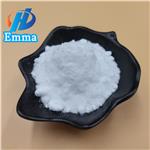
US $100.00-30.00/kg2024-04-16
- CAS:
- 137-58-6
- Min. Order:
- 1kg
- Purity:
- 99.3%
- Supply Ability:
- 1000kg per week
